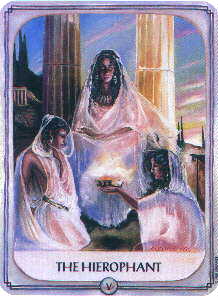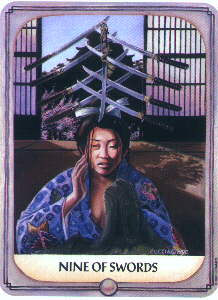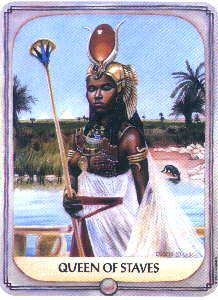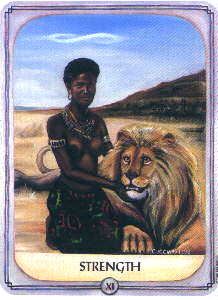 Ancestral
Path Tarot
Ancestral
Path Tarot Ancestral
Path Tarot
Ancestral
Path TarotI was expecting not to like this deck very much. I was attracted to the artwork, but the general plan (assigning each suit to a different racial/cultural group) was something I wasn't too enthusiastic about, expecting it to degenerate into a kind of superficial tokenism that would detract from using the cards. I also resist the modern trend to portray the ancient Eqyptians as though they were sub-Saharan Africans. There were many great civilizations in sub-Saharan Africa that can be used to illustrate the cultural richness of this branch of humanity; it is not necessary to revision Egyptians as black, a move whose historical support is tenuous at best. I have similar misgivings about the appropriation of native American and Asian cultures to serve the interests of modern American cultural dabblers.
 This
was what was running through my mind before I opened the box.
Afterwards, it was a different story entirely.
This
was what was running through my mind before I opened the box.
Afterwards, it was a different story entirely.
Cuccia-Watts is an extraordinary artist, with a real gift for portraiture. These paintings are no simple stereotypes, hurriedly rendered and packaged for sale. There is real depth in each one, and the people depicted have an individuality that speaks on a personal level. One soon loses the feeling of triteness that "four suits = four races" suggests, and the cards become scenes in an integrated human epic, reaching into the far corners of time--both historic time and imaginary time.
Slowly, too, other subtleties emerge. Each of the four suits actually represents the intersection of two distinct cultures: the Arthurian saga depicted in the cups springs from the synthesis of Celtic paganism and Latin Christianity; the Native American motif of the sacred circles is post-contact, and thus incorporates European influences; the swords mix Japanese and Ainu cultures; and lastly (and now more justifiably) the staves draw from both Nubian and Mediterranean influences in Egypt. Strict historicity is not observed, but that doesn't matter, because the vision of the project is not principally historical--rather it is to show the human unity that underlies the many faces and stories of the world.
 The
paintings are skillful in another respect, too: the use of color and
light produces a real sense of place for each of the four
suits, so that one feels like a traveler in both time and space as
different cards are examined in succession. The scenes flow
effortlessly between the world of fact and the world of myth, so that
in the end we are exploring the geography of the realm of
story.
The
paintings are skillful in another respect, too: the use of color and
light produces a real sense of place for each of the four
suits, so that one feels like a traveler in both time and space as
different cards are examined in succession. The scenes flow
effortlessly between the world of fact and the world of myth, so that
in the end we are exploring the geography of the realm of
story.
The companion book for the deck is a more worthy effort than is typical for tarot sets. The author, Tracey Hoover, was a collaborator of sorts in the artist's project (she is depicted on the Fool card), and has some very good insights into the meaning of the imagery. The references to myth and legend are described with fair detail, and the unique qualities of the designs are brought out; Hoover does not take the "easy way out" of uncritically reciting standard meanings. The book is a must, especially if you want to be aware of the story elements that are so much a part of the minor arcana in this deck.
 The
major arcana are intended to fuse many times and places into
archetypal images, and they succeed. There are some modern
perspectives: the World is a globe in space, the Hanged One is a
fetus in the womb. The Magician is a shaman who seems to have access
to both the neolithic world and the twenty-first century. Yet,
miraculously, there is such a unity of atmosphere that the cards seem
to always belong together, no matter how diverse their sources.
The
major arcana are intended to fuse many times and places into
archetypal images, and they succeed. There are some modern
perspectives: the World is a globe in space, the Hanged One is a
fetus in the womb. The Magician is a shaman who seems to have access
to both the neolithic world and the twenty-first century. Yet,
miraculously, there is such a unity of atmosphere that the cards seem
to always belong together, no matter how diverse their sources.
It is amazing to me that this deck was ever completed. Each painting is so finely and carefully worked that it looks to be the product of at least a year's effort. There are an unusual number of brilliant, unforgettable images in this deck: Strength, The Tower, Ten of Staves, Queen of Staves, Nine of Swords--just to name a few.
In reading, I find this is a deck with a tremendous reach. It shows images from a thousand years ago, or a thousand years in the future, from places remembered, forgotten, or imagined. It follows the roots of a question into the shadows of the past, and extrapolates effects into eons yet to come. The reader sits at the nexus of a story that has no beginning, no ending, and no boundaries.
Return to Tarot entry page
Return to Telperion Productions entry page
Copyright © 1999 Tom Tadfor Little